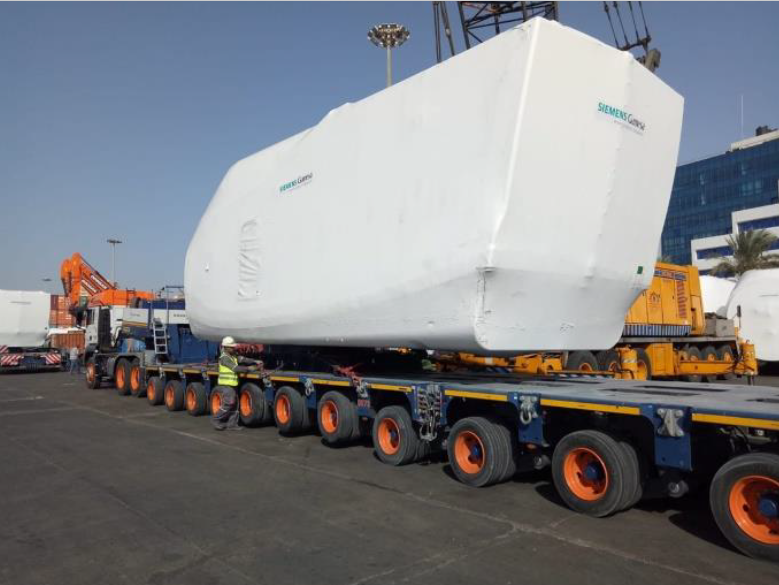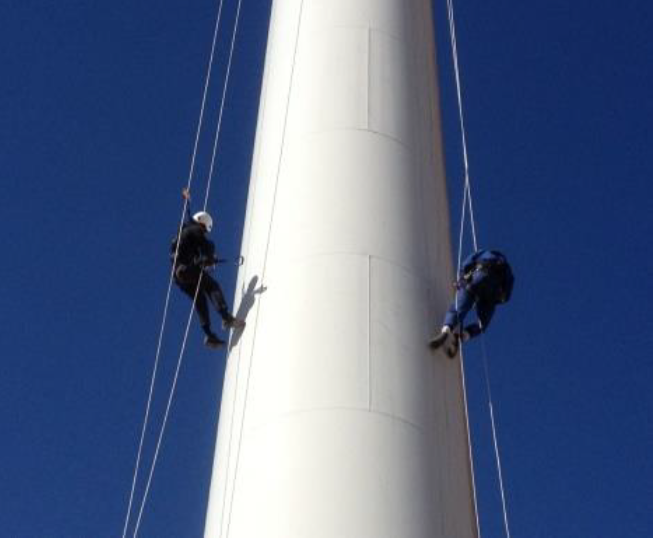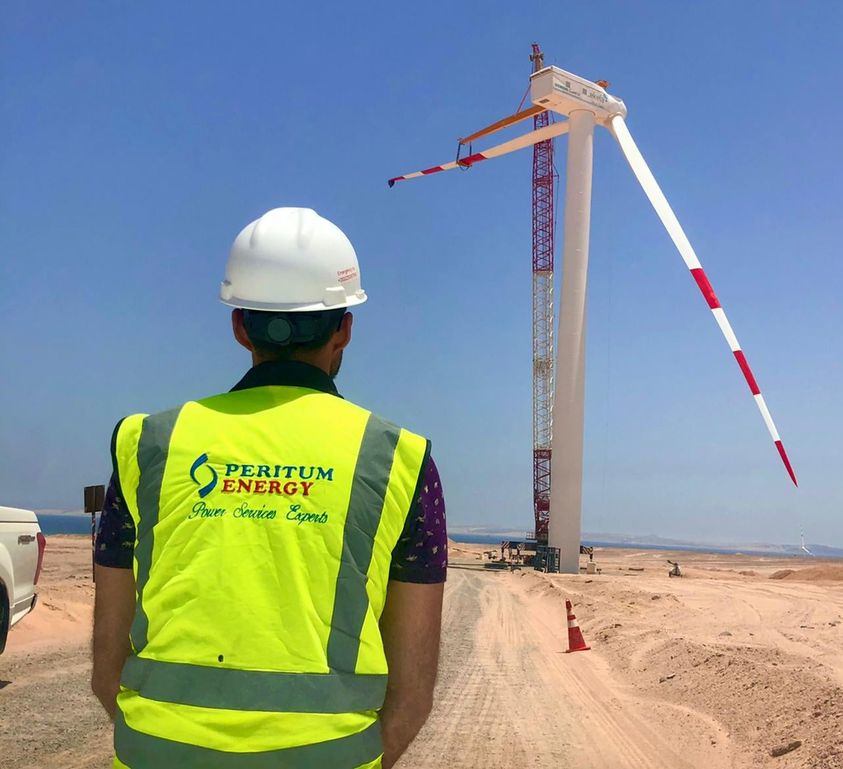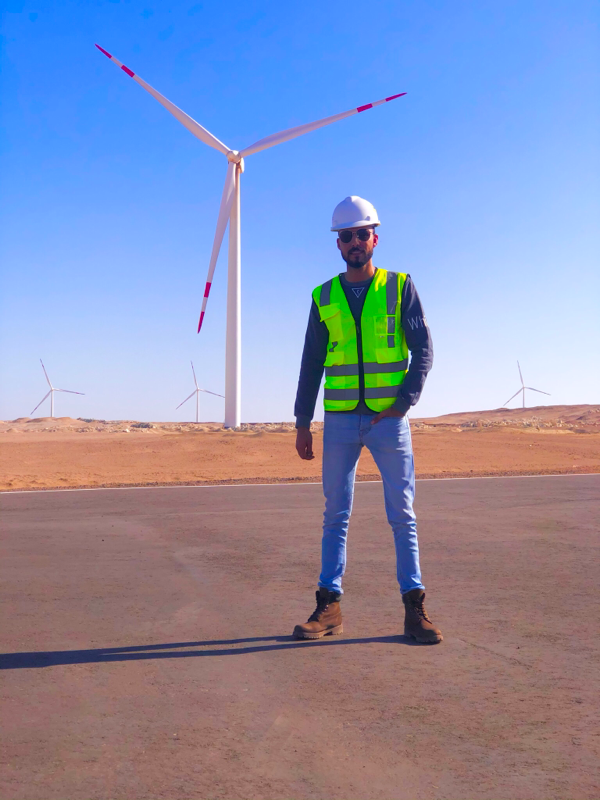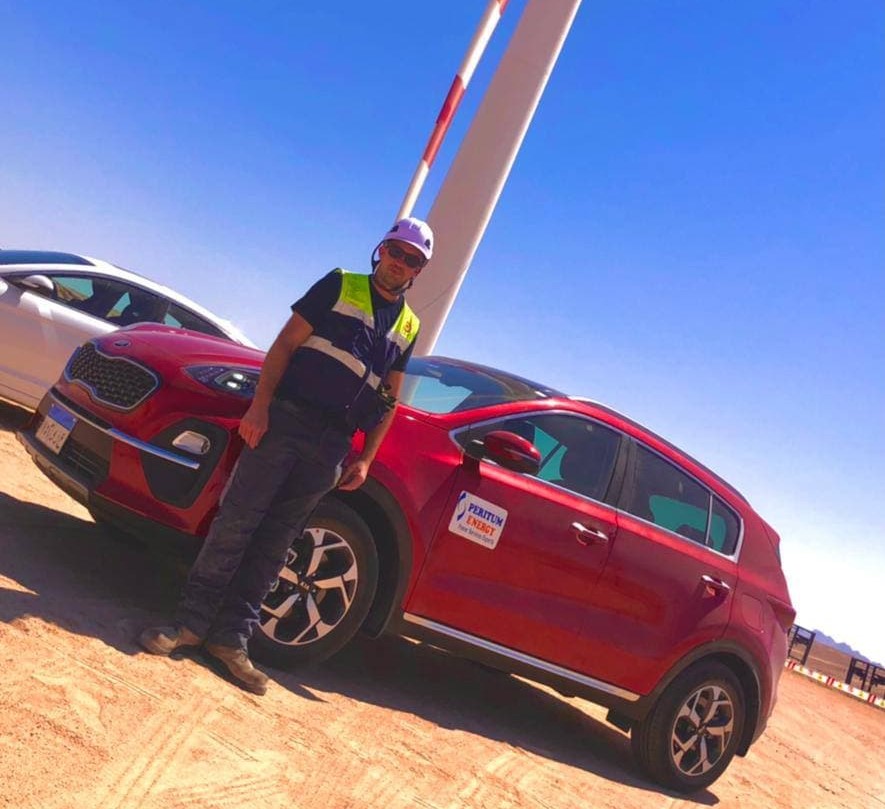WIND
Wind
Currently, the world tends to rely on renewable energy resources such as wind, tidal and solar energy, for several reasons:
1) To reduce the risks arising from the use of traditional energy sources such as petroleum and natural gas.
2) Control the problem of global warming and melting ice at the poles.
3) Renewable energy sources are clean, environment-friendly, inexhaustible and They produce no emissions like greenhouse gases (greenhouse gases).
One of the most important sources that are relied upon in the production of renewable energy is wind energy.
Wind energy is the energy extracted from the movement of the wind using wind turbines, and it is electromechanical energy.
And wind energy needs large areas for its production, and these areas differ according to the size of the station and the type of towers used.
It is preferable to construct stations away from residential compounds and rural areas, due to the presence of obstacles preventing the use of high wind speeds such as buildings and tall trees.
According to 2013 statistics, Denmark is the world's largest user of wind energy, as it generates more than a third of its electricity needs from wind. Also, 83 countries around the world are using wind energy to boost their electricity networks. Wind power capacity expanded rapidly to 336 gigawatts in June 2014, so wind energy production recorded around 4% of total electricity consumption worldwide, and this percentage is constantly increasing.
Despite its abundant production in regions with high wind speeds, one of its disadvantages on the utility-scale is that its peak production does not usually coincide with peak consumption, which does not contribute to reducing the burden on conventional electricity production stations during peak consumption. As for the household scale, its biggest disadvantage is that the production from wind turbines does not carry the characteristic of sustainability, and to avoid this, the production can be utilized by directly connecting it to the public electricity grid or installing batteries to store that energy and use it throughout the day. Usually, in off-grid electrical systems on a household scale, wind energy is not used alone without the presence of other sources of renewable energy such as photovoltaic energy, for example, until both support each other and increase the reliability of electricity production.
The principle of producing electricity from wind is based on converting the wind turbine to the wind heading towards it into mechanical energy, as the blades that make up the turbine, when rotating, capture the kinetic energy of the wind, then transfer it through an arm to an inner column, to double this mechanical kinetic energy by the controller to increase the rotating force and then It passes to an electrical generator that produces electricity, where the electrical energy generated from more than one wind farm is collected and transferred to the main electricity grid to be utilized. The wind turbine consists of three blades on a steel shaft with a height of 80 meters. It also contains a part called the nickel that includes the generator, shaft, gearbox, and controller that doubles the speed of the kinetic energy transmitted to it.
Advantages of producing energy from wind:
1) low cost Producing energy using wind is one of the least expensive methods of generating power, as it does not require a high cost to establish the project, and it can also benefit from the electricity it produces, which reduces the costs involved.
2) A clean source Wind energy is characterized by being clean, as it does not cause air pollution as well as from burning fossil fuels to generate electricity.
3) A permanent and renewable source is a permanent and inexhaustible source because it is formed by solar energy that heats the air, which leads to its movement and rotation, producing wind.
1. Legal information
1.1. According to article 10 of the Spanish Act 34/2002, of 11 July, regarding the information of company services and electronic commerce we provide the following information:
Name: GLOBAL ENERGY SERVICES SIEMSA SA (PERITUM ENERGY)
Address: Parque Tecnológico Bizkaia Edificio 407-48170 Zamudio– Vizcaya (Spain).
Tax I.D. number: A82509779
Telephone: (+34) 944 712 131
E-mail: ges@services-ges.com
Data of registration in Trade Register of Bizcay Page: 142 Volume: 5471
2. Data protection
2.1. By filling the registration or contact form, sending an e-mail or calling by telephone, your personal data shall become the responsibility of the company whose data are referred in 1. Legal Information.
Furthermore, the user is informed that his/her professional and contact data shall be provided for processing to other entities belonging to PERITUM ENERGY Group and to investee companies of any of the companies that make up PERITUM ENERGY Group.
2.2. These data are used to respond to your request or query as soon as possible and to communicate with you commercially, because you provide us informed and freely for these purposes.
If you provide us with a curriculum, your data shall be used to incorporate it into present and future selection processes in our company and to communicate with you, even electronically, in relation to your application.
For other processing or purposes related to provision of our services or the development of our activity, you can request more information at our contact address.
2.3. Personal data collected on our website are processed according to Regulation (EU) 2016/679 of the European Parliament and of the Council, of 27 April 2016, on the protection of natural persons with regard to the processing of personal data and on the free movement of such data.
2.4. Moreover, we guarantee that personal data are processed in a lawful, fair and transparent manner, and are collected for specific, explicit and legitimate purposes, remaining limited to these purposes and updated if necessary. The identification of applicants shall not be allowed longer than necessary and their security shall be guaranteed by appropriate technical and organisational measures.
2.5. Once the data are not necessary for the purposes for which they were collected, they shall be preserved at the disposal of the competent public administrations during the legal terms of preservation, that is to say as long as an act may require us to present them. If these time limits expire, they must be deleted.
2.6. You may exercise the rights of access, rectification, erasure and objection as well as other rights granted by the legislation on the protection data regarding personal data by submitting a copy of an identification document to PERITUM ENERGY - Parque Tecnológico Bizkaia Edificio 407 - 48170 Zamudio – Vizcaya (Spain).
2.7. You can find further information regarding your rights or lodge a complaint to the competent authority of control at the Spanish Data Protection Agency http://www.agpd.es - C/ Jorge Juan, 6. 28001 – Madrid (901 100 099 - 912 663 517).
3. Limitation de Liability
3.1. PERITUM ENERGY provides the corporate website as a means of publicising its products and services and allowing the contact with clients. The information of the website is presented only for indicative or informative purposes and shall not be considered biding at any time. For contacting the products or services of the entity, the provisions of budgets and contracts duly formalized shall apply.
3.2. The entity is not responsible for any possible informatics damage that user may suffer while visiting our website, understanding that these cannot be attributed to the entity.
3.3. The entity is also not responsible for the content of sites managed by third parties that are linked from the website, and such links shall not imply the existence of any kind of relationship by PERITUM ENERGY with those third parties.
4. Intellectual Property
4.1. All the contents in this website, understanding as such texts, drawings, graphics, photographs, images, videos, music, code, the design of the same and any other creation are propriety of PERITUM ENERGY or its respective owners by means of the corresponding licence, authorization or transfer of rights and are protected in function of the legislation regarding Intellectual and Industrial Property.
4.2. Under no circumstances shall it be understood that making the website available to the public constitutes surrender, transfer or licence of rights that PERITUM ENERGY has over these contents.
Any use of the contents our website, including modification, copying, reproduction, transmission, etc. is prohibited without the previous written authorization of the entity.
ASSET AND SERVICE PURCHASE GENERAL CONDITIONS
1. OBJECT
This document is aimed at regulating the general conditions to be applied for purchasing assets and services by any company in the GES Group (Global Energy Services Siemsa S.A., Siemsa Control y Sistemas S.A., and Siemsa Industria S.A.U.)
The terms of business of Suppliers or third parties shall not apply, even if in an individual case GES does not oppose them separately. Even if GES makes reference to a letter, which contains the business conditions of the Supplier or a third party or refers thereto, this shall not be deemed to be an agreement as to the validity of those terms of business.
2. PRICES AND DELIVERY DEADLINES
They are firm and not subject to modifications.
The negotiated time of delivery or performance shall be binding upon the Supplier.
The Supplier agrees to notify GES immediately if circumstances occur or become apparent according to which the time of delivery or performance cannot be met.
The Supplier is not authorised to effect partial deliveries and performances, unless this has been approved by GES in writing. In this case, the fulfilment of the contract shall apply within the scope of the partial performance Items of delivery must be supplied with test records and certificates. Otherwise, GES is authorised to refuse acceptance.
3. DELIVERY
3.1. The goods will be delivered to the address on the order and the Vendor will be responsible for the transport, insurance and unloading the equipment (D.D.P. Incoterms 2010), who will keep the goods until received by GES.
The delivery will be carried out in the specific period that appears on each order.
In the event of the non-observance of the delivery date, GES reserves the right to:
3.1. a Consider the order as firm applying a 2 per cent penalty on the Supplier on the total amount of the order per week or fraction of delay with a limit of 10%, The Supplier will also indemnify GES in respect any Losses or damages which GES may suffer as a result of such delay.
3.1.b. When the delay is over 4 weeks, the order will be considered cancelled, in which case GES only has to notify in writing. The Supplier will also indemnify GES in respect any Losses or damages that GES may suffer as a result of such delay
3.2. GES is authorised to modify, with no extra cost for GES, the time and place of delivery at any time by written notice to the Supplier, with a time limit of at least seven calendar days prior to the agreed upon date of delivery. The delivery dates may be postponed by GES, with no extra cost for GES, by up to six months as of the original date of delivery.
The same applies to amendments in product specifications provided if said amendments in specifications can be implemented within the scope of the Suppliers' regular production process without considerable additional expenditure of time, in which in these cases, the notice period according to the former paragraph shall be at least 10 calendar days. If such modifications will have unavoidable delays as a consequence, the time of performance shall be postponed correspondingly.
3.3. GES shall reimburse the Supplier the verified and reasonable additional costs incurred by a modification if it has not been notified to the Supplier in terms fixed in former clause. The Supplier shall notify GES immediately of the expected additional costs and/or anticipated delays in delivery.
4. RECEIPT
No materials will be accepted that arrive without a delivery note indicating the number of packages, weight of the goods, measurement unit, quantity, material reference, order number and works number corresponding to the delivery, attaching the delivery receipt and/or road haulier accreditation document to the delivery note.
5. RETURNS AND REJECTIONS
GES does not assume any responsibility for materials delivered exceeding those included in its reference order, even when they have been admitted in its warehouses, although it does reserve the right to return these quantities paid for by the sender. In the same way, the goods rejected by GES's Quality Control or any of its managers, will be returned to the supplier COD, without affecting GES's rights, in application of condition 3, to claim for the corresponding compensation.
GES will have 2 weeks, except for circumstances beyond its control, for checking the materials.
6. PACKING
The packing of the goods will be undertaken by the supplier, and no charge for this concept will be accepted, except after a specific agreement in this sense.
7. INVOICING
The invoices will be made out to and sent to GES, and will be accompanied by their corresponding duly signed delivery notes.
GES's order number must figure on the invoices along with the works number, and this data will be essential for paying the invoices.
8. PAYMENT METHOD AND PERIOD
The payments will be made according to the payment terms specified in the order. Usually it will be done by bank transfer on the monthly payday to be defined, unless stated otherwise in the order.
9. RESERVATION OF RIGHTS
The studies, plans, projects, drawings, documents, models and tools provided by GES for the services that may be subject to any order, will be its exclusive property, and it can request them to be returned whenever it deems necessary. Except for express authorization in writing by GES, the Vendors cannot give the studies, plans, projects, models, tools, or the parts that may be built in accordance with GES's plans or specific indications to third parties under any circumstance.
GES reserves the right to carry out on its own or using an authorised representative, the inspections it considers necessary during or at the end of the manufacturing or in the final destination of the assets or services included in the supply. The Vendor is obliged to provide GES with all the necessary means for properly carrying out its inspections. The inspection carried out by GES does not absolve the Vendor of any contractual responsibility.
10. SUBCONTRACTING
Except for express written authorisation by GES, the total or partial subcontracting or assignment of the order is prohibited.
11. GUARANTEES
The Vendor guarantees that the goods subject to the order are top quality, work correctly, are free of any kind of design, manufacturing and/or material faults and/defects, and comply with the quality control system established in the specifications, plans and other instructions provided by GES. The Vendor undertakes replacing faulty goods with no cost whatsoever for GES. Nevertheless, GES, in the event of the Vendor's failure to comply, reserves the right to carry out, on its own, this replacement, and will charge the Vendor for the expenses originated and will demand, where applicable, compensation for damages. The guarantee period will be at least 30 months from the delivery of the equipment or 24 months from issuance of Provisional Acceptance Certificate , whichever occurs first. To cover this guarantee, the Vendor will obtain the guarantees required by GES in the corresponding contracts.
Upon the Supplier's receipt of GES's written notification of defects, the statutory period of limitations shall be suspended. In the case of replacement deliveries and subsequent improvements, the statutory period of limitation will restart for the replaced or improved parts
12. TAXES
The taxes and fiscal stamps that may result from this order, as well as any other tax from the State, Province, Municipality or Autonomous Community, will be paid by the Vendor, with the exception of the corresponding VAT to be applied.
13. ORDER ACCEPTANCE
All orders have to be returned signed and stamped in the maximum period of one week from signing the order. This requirement is essential for the correct processing of the invoices derived from each order.
The issued orders will be of a Purchase Contract nature, and will be formalised when signed by the Vendor and sent to GES by a channel of communication for which the reception is verifiable..
14. SERVICE CONTRACT
The Vendor promises to fulfil the requirements and instructions included in the special conditions applicable to the service contract or indicated from GES on Quality, Environment and Occupational Risk Prevention matters. The special conditions applicable to service contracts will also have the following requirements prior to issuing the order, without affecting the required documentation before the start of the service provision in accordance with GES’s subcontracting procedure.
14.1. Mutual Insurance Company Document / Work Accident and Occupational Disease Policies.
14.2. Health Surveillance Contract (proof or receipt).
14.3. Company Prevention Mode (Own, joint, mutual…) with contract.
14.4. Memorandums of Association, National Identity Card and Sufficient Power of the Company Representative to sign the Contract.
14.5. Civil Responsibility and damages to third parties Insurance Policy.
14.6. Contractor / Subcontractor Certificate (Tax Office).
14.7. Social Security contribution situation certificate.
14.8. Collective Agreement Accident Insurance Policy, if applicable.
15. PUBLICITY
The Vendor cannot use, for publicity reasons, any element included in the order without the prior written authorisation of GES.
16. CANCELLATION
GES, in special circumstances, can cancel the order totally or partially, by notifying in writing to the Vendor. On receiving this communication, the Vendor will cancel any work or supply related to the order.
17. ORDER COMPLETION
The order will be considered fulfilled when the goods and the requested documentation have been delivered by the Vendor to GES, without affecting the stipulations in the guarantee section.
18. MODIFICATIONS
Whether any modifications to these General Terms and Conditions apply to existing and/or future contracts between GES and the Vendor shall be established by joint and written agreement between them.
19. CORPORATE SOCIAL RESPONSIBILITY
Seller agrees to carry on his business respecting and promoting the following principles:
19.1 Respect for Human Rights
19.2 Compliance with Legislation in force, including Environmental and Health and Safety Legislation.
19.3 Fight against child labour or forced labour, employment discrimination and unfair practices on employees.
19.4 Performance of business based on ethical business practices.
19.5 Compliance with Export Control Rules and Regulations.
20 SEVERABILITY CLAUSE
Should individual provisions of these terms and conditions be void or invalid, this shall not affect the validity of the remaining provisions hereof. In this case, the provision, which is invalid in whole or in part shall be replaced by a relative provision, the economic success of which comes as close as possible to the invalid provision.
21. APPLICABLE LAW
These General Conditions shall be construed, interpreted and enforced in accordance with, and governed by, the laws of the Country of Spain, exclusive of its choice of law rules.
22. JURISDICTION
Each of the parties whom these General Conditions apply, hereto submits to the jurisdiction of courts sitting in city of Bilbao, any action or proceeding arising out of or relating to such General Conditions and agrees that any Claims in respect of the action or proceeding may be heard and determined in such court. Each of the parties hereto waive to any other jurisdiction that may correspond and agree not to bring any action or proceeding arising out of or relating to this General Conditions in any other court. Each of the parties waives any defence of inconvenient forum to the maintenance of any action or proceeding so brought.
